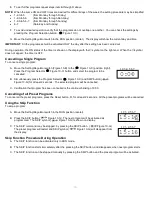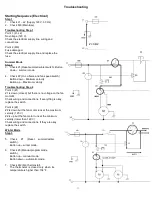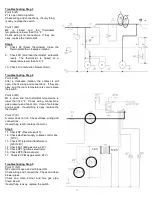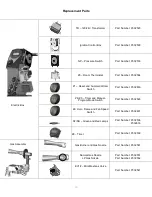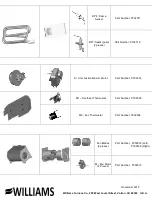
High Altitude Adjustment
Based on the altitude of the installation site, reduce the manifold pressure specified in the “Technical Data” chart and as shown
in the table below:
Altitude
Manifold Pressure
Reduction Rate
0-2,000 ft
0%
2,000-3,000 ft
8%
3,000-4,000 ft
16%
4,000-5,000 ft
24%
5,000-5500 ft
32%
First Firing the Furnace
Start the furnace following the instructions given in the “Operating Instructions”. The first lighting may be difficult because of the
air trapped in the gas lines. During initial firing of the furnace, residual manufacturing grease will bake out and smoke will occur
which is not a health danger. To prevent nuisance and operation of fire alarms, ventilate the room for the first two hours of
operation.
Checking the Gas Inlet Pressure
The gas inlet pressure can be measured by connecting a test gauge to the connection provided on the gas valve. (Figure 8 - A)
Once installation is complete, the gas inlet pressure must be checked. The minimum gas inlet pressure must be as shown in
“Technical Data”. After checking the gas inlet pressure, disconnect the test gauge and firmly tighten the screw of the gauge
connection, then check for gas leaks. Correct any gas leaks before operating the furnace.
Checking the Gas Manifold Pressure
The gas manifold pressure can be measured by connecting a test gauge to the connection provided on the gas valve. (Figure 8 -
B). The furnace comes set from the factory at the correct manifold gas pressure. After the installation is completed, the gas
manifold pressure must be checked both in Hi and Lo input. Turn the control knob to switch the unit from Hi to Lo input. The
position of the knob in which this occurs depends on the actual room temperature. The gas manifold pressure must be as shown
in “Technical Data”. Differences of plus or minus 0.1 in. w.c. are acceptable. If the Hi or Lo gas manifold pressures are different
from the values given in the “Technical Data” or are more than 0.1 in. w.c., shut off the furnace and contact a qualified service
technician for correction.
For instructions about adjustment of the manifold Hi and Lo pressures, see the "Servicing” section. After checking the gas
manifold pressure, disconnect the test gauge and firmly tighten the screw of the gauge connection, then check for gas leaks
from it. Correct any gas leaks before operating the furnace.
A
B
C
D
F
E
A. Test gauge connection for gas inlet
pressure
B. Test gauge connection for gas manifold
pressure
C. Nut for Hi pressure adjustment (pressure
regulator)
D. Screw for Lo pressure adjustment (Hi-Lo
operator)
E. Electric clamp connection
F. Gas supply inlet
Figure 8
11



















